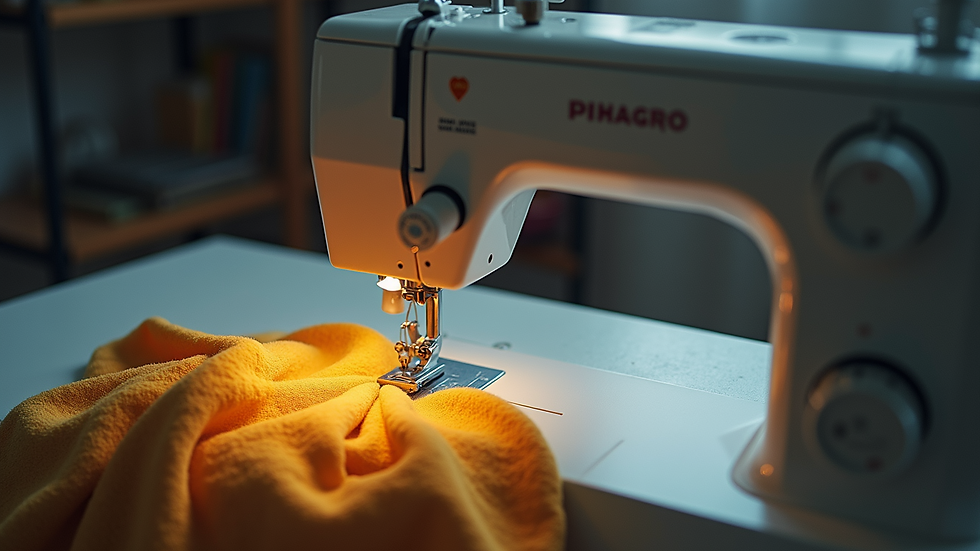Tips for Working with Different Types of Fabric
- info160094
- Jul 9
- 4 min read
Choosing the right fabric is crucial for any sewing project. It can impact not only the final look of your creation but also how easy or challenging it is to work with. This blog will explore various fabric techniques, discuss different types of fabric, and share tips on how to handle them effectively. Get ready to unlock your sewing potential!
Understanding Fabric Techniques
Fabric techniques refer to the various methods and skills required to handle different materials effectively. Understanding these techniques can make a significant difference in achieving high-quality results. For instance, some fabrics fray easily and require specific seams to prevent unraveling, while others may stretch or shrink in unexpected ways. Knowing how to work with these aspects can save you time and frustration.
Tips for Choosing Your Fabric
When selecting fabric for your project, consider the following:
Project Type: What are you making? Dresses, quilts, and home décor items may require different fabric choices.
Fabric Weight: Lighter fabrics are usually easier to sew but may be less durable. Heavier fabrics provide structure but can be challenging to handle.
Fiber Content: Cotton, silk, polyester, and wool each have unique properties. For example, cotton is breathable, while silk drapes beautifully but may need special care.

Common Fabrics and Their Uses
Understanding the different types of fabric will help you make informed decisions. Here are some common fabrics and their uses:
Cotton: This versatile fabric is great for quilting and clothing. It's easy to sew and comes in many colors and patterns.
Silk: Known for its luxurious feel, silk is excellent for evening wear and blouses but can be slippery to sew. Use a fine needle and lightweight thread.
Linen: A strong fabric that wrinkles easily, linen is perfect for summer clothing and home textiles. It's breathable but requires careful handling during sewing.
Wool: Typically used for coats and suits, wool provides warmth but can be bulky. Learning to work with wool requires special techniques to ensure the best finish.

Knits: These stretchy fabrics are ideal for t-shirts and activewear. They require specific stitches to maintain their elasticity.
Knowing these fabric traits can help you select the appropriate type for your sewing project.
What are the 10 Types of Sewing Professionals?
Here are some common types of sewing professionals you may encounter:
Fashion Designers: Create clothing and accessories using various fabric techniques.
Tailors: Specialize in altering and fitting garments for the perfect fit.
Quilters: Focus on sewing layers of fabric together into quilts, often using intricate designs.
Costume Designers: Create costumes for theater, film, and television, often requiring a variety of fabric techniques.
Interiors Specialists: Work on upholstery and home décor items like curtains and cushions.
Embroiders: Add embellishments to garments or textiles using sewing techniques that enhance the visual appeal.
Pattern Makers: Create templates for garments, essential for large production runs.
Sewing Instructors: Teach sewing skills and fabric techniques to beginners and experienced sewists.
Bespoke Seamstresses: Offer custom garment creations tailored to individual clients’ needs.
10. Fabric Technologists: Focus on the scientific and technical aspects of textiles to improve their properties.
Each professional has unique skills that contribute to the rich tapestry of the sewing world.
Essential Tools for Working with Fabrics
Having the right tools can significantly improve your sewing experience. Here are some essentials:
Sharp Scissors: Invest in a good pair of fabric scissors for clean cuts.
Measuring Tape: Accurate measurements are required for any sewing project. A flexible measuring tape is ideal.
Pins and Clips: To hold fabric pieces together while you sew, use either traditional pins or fabric clips for knits and delicate materials.
Sewing Machine: A reliable sewing machine will make your work much easier. Familiarize yourself with its functions to maximize its potential.
Iron and Ironing Board: Pressing seams and fabric before sewing can result in neater finishes.
Utilizing the right tools can help simplify the sewing process and improve the quality of your finished product.

Advanced Fabric Techniques
Once you've mastered the basics, consider exploring advanced techniques. These include:
Bias Binding: This technique provides a clean finish for edges and is great for curved hems.
French Seams: Ideal for delicate fabrics, French seams encase the raw edges to prevent fraying.
Serging: Using a serger can make finishing seams faster and cleaner. It's particularly beneficial for knit fabrics.
Darts and Tucks: These can help shape garments for a better fit and are essential in your sewing repertoire.
For those looking to expand their skills, you might explore advanced fabric sewing techniques that can elevate your projects.
Mastering Fabric Care
Proper care extends the life of your fabric and finished projects. Here are some tips:
Washing: Always read the care label. Some fabrics require hand washing, while others can be machine washed on delicate cycles.
Drying: Hang or lay flat to dry when possible. Avoid tumble drying delicate fabrics like silk to maintain their integrity.
Ironing: Use the appropriate heat settings according to the fabric type. Test on a small area if unsure.
Caring for your fabric correctly will give your creations a longer lifespan and better appearance.
Final Thoughts on Fabric Handling
Incorporating the right techniques and tools into your sewing practice will make working with different types of fabric easier and more enjoyable. Remember to always choose fabric based on your project requirements and let your creativity flow. Happy sewing!







Comments